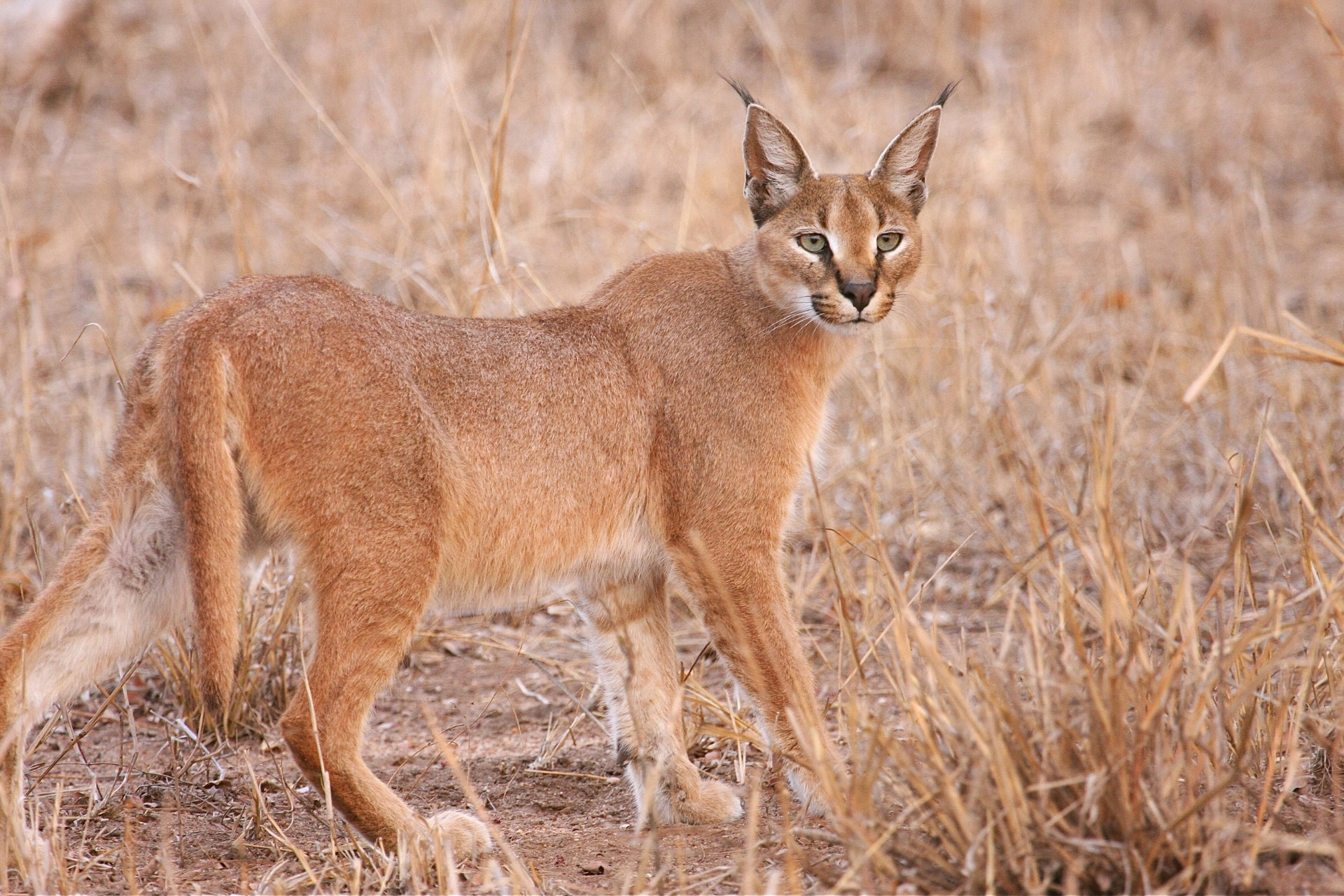5 Fascinating Facts About the Caracal
Facts About the Caracal
The Mysterious Feline with the Velvet Ears
Sleek, elusive, and shrouded in ancient mystique, the Caracal is a wild cat unlike any other prowling the African wilderness. With its elegant build, piercing gaze, and signature tufted ears, this creature evokes both curiosity and admiration. Often mistaken for a lynx due to its ear tufts, the Caracal (Caracal caracal) is in fact a species all its own—a remarkable predator adapted to thrive in the varied terrains of Africa, the Middle East, and Central Asia.
The Caracal’s mystique goes beyond its appearance. It has been a subject of ancient art, admired by royalty, and celebrated for its agility and cunning. Delving deeper into the life of this secretive feline reveals a creature that is not only stunning but also biologically and behaviorally fascinating. In this exploration, we uncover five captivating aspects of the Caracal’s life, drawing attention to why it deserves a spotlight in Africa’s majestic wildlife pantheon.
Exceptional Agility and Jumping Ability (Facts About the Caracal)
One of the most breathtaking capabilities of the Caracal is its unmatched agility. This cat is among the most athletic of all small wild cats, capable of leaping up to three meters into the air to catch birds in mid-flight. Its body is built for this aerial prowess—with powerful hind legs, a flexible spine, and precise coordination. What makes this ability even more remarkable is how the Caracal utilizes it in hunting.
In areas where ground prey is scarce or difficult to capture, the Caracal has been observed sitting silently in grassy patches, waiting for unsuspecting birds to take flight. Then, with a sudden burst of energy, it propels itself upward, sometimes catching multiple birds in a single jump.
This behavior is not only a testimony to its physical excellence but also an indicator of its highly developed hunting instincts and environmental awareness. The Caracal’s speed and stealth allow it to adapt to different prey types, from rodents and hares to gazelles and fowl. It stalks its prey silently and strikes with surgical precision, leaving little room for escape.
Distinctive Ear Tufts and Communication
The Caracal’s most visually distinctive feature is its long, black ear tufts, which can grow as long as five centimeters. While these tufts contribute to its alluring appearance, their function goes beyond aesthetics. Scientists believe that the tufts play a crucial role in communication, particularly in environments where visual cues must be subtle.
These tufts may enhance facial expressions and help convey mood or intent to other Caracals. Additionally, they could act as camouflage, breaking the outline of the ears and helping the animal remain hidden in the underbrush.
The Caracal’s hearing is also among the sharpest in the animal kingdom. Its large ears can rotate independently and are finely tuned to detect the faintest of movements. This acute hearing, combined with its visual capabilities, gives the Caracal an edge as both a predator and a solitary creature navigating large territories. Each ear movement, flick, and tilt is part of a complex system of non-verbal language that makes the Caracal an intricate communicator within its ecosystem.
Solitary Nature and Territorial Intelligence
Unlike lions or cheetahs that sometimes hunt or travel in groups, Caracals are profoundly solitary. They prefer the quietude of remote terrains, from savannahs and deserts to mountains and shrublands. Each Caracal maintains a vast territory, the size of which depends on the availability of prey and the density of the habitat. Males have significantly larger ranges that often overlap with the smaller territories of several females. However, outside of mating seasons, they rarely encounter each other.
This solitary existence requires a heightened level of territorial intelligence. Caracals use a variety of scent markings, vocalizations, and visual cues to communicate boundaries and reproductive status. They are known to be highly mobile, often traveling several kilometers a day to patrol and secure their domain. Such movement is strategic, ensuring that they encounter fresh prey and avoid unnecessary confrontations with rivals.
The Caracal’s solitary habits also inform its parenting strategy. Females are fiercely protective of their young and raise them without any help from the males. Cubs remain with their mothers for several months, learning the essentials of survival, hunting, and territorial navigation before venturing into independence.
Cultural and Historical Significance
The Caracal holds a revered place in the folklore and history of several cultures. In ancient Egypt, Caracals were often depicted in art, and their images have been found in tombs and temples. These depictions suggest that the Caracal was associated with nobility, grace, and protection. Some scholars even believe that the famous “guardians” painted on royal sarcophagi may have been inspired by the Caracal, revered for its alertness and sharp features.
In India and Persia, Caracals were trained for sport hunting and were particularly valued for their ability to catch birds during falconry events. This practice was considered elite and was reserved for the noble class. These historic references underscore the Caracal’s longstanding allure and the high regard in which it was held across civilizations.
Today, while not commonly featured in mainstream media like lions or cheetahs, the Caracal remains a symbol of wild elegance. It represents the silent, powerful presence of untamed nature and the sophisticated balance of survival and grace.
Conservation Concerns and Human-Wildlife Conflict
Although the Caracal is not currently listed as endangered, it faces several conservation challenges, particularly in areas experiencing rapid human encroachment. Habitat loss due to agricultural expansion and urban development is one of the primary threats to Caracal populations. As their territories become fragmented, these solitary cats are forced into closer proximity with human settlements, often leading to conflict.
In some regions, Caracals are considered pests by farmers who accuse them of preying on livestock, particularly poultry and small ruminants. In retaliation, they are sometimes trapped or poisoned, leading to localized declines in population. Additionally, illegal hunting for their pelts and body parts continues in some parts of Africa and Asia, despite legal protections.
Conservationists are working to mitigate these threats through education programs, community-based wildlife management, and habitat restoration. Creating awareness about the Caracal’s ecological role and promoting non-lethal conflict resolution methods are key steps in ensuring its survival. It is imperative to remember that the Caracal, like all wildlife, plays a crucial role in maintaining the health and balance of its ecosystem.
Witness the Wild Elegance of the Caracal with WildHorn Africa
To truly appreciate the beauty and complexity of the Caracal, one must see it in its natural habitat—gracefully weaving through the grasslands, ears perked, eyes focused. Such moments are rare but unforgettable, and they offer a deep connection to the rhythm of wild Africa.
WildHorn Africa offers expertly guided safaris that increase your chances of encountering this elusive feline, along with many other awe-inspiring species. Whether you’re exploring the rugged deserts of Namibia, the savannahs of Kenya, or the mountainous terrains of South Africa, WildHorn Africa curates journeys that blend adventure, education, and conservation.
Book your African safari with WildHorn Africa and take the first step toward witnessing the untamed elegance of the Caracal. Let your journey be more than just a trip—make it a celebration of wild beauty and a contribution to the future of Africa’s precious wildlife.
Facts About the Caracal #Facts About the Caracal Facts About the Caracal





 WildHorn Africa – Authentic and unforgettable tours across Africa, guided by local experts who know the land, wildlife, and culture best.
WildHorn Africa – Authentic and unforgettable tours across Africa, guided by local experts who know the land, wildlife, and culture best.


